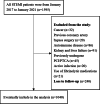The HALP score predicts no-reflow phenomenon and long-term prognosis in patients with ST-segment elevation myocardial infarction after primary percutaneous coronary intervention
- PMID: 39492724
- PMCID: PMC12043261
- DOI: 10.1097/MCA.0000000000001446
The HALP score predicts no-reflow phenomenon and long-term prognosis in patients with ST-segment elevation myocardial infarction after primary percutaneous coronary intervention
Abstract
Introduction and objective: Despite recent advances in the management of ST-segment elevation myocardial infarction (STEMI), the clinical outcome of some patients is still unsatisfactory. Therefore, early evaluation to identify high-risk individuals in STEMI patients is essential. The hemoglobin, albumin, lymphocyte, and platelet (HALP) score, as a new indicator that can reflect both nutritional status and inflammatory state of the body, can provide prognostic information. In this context, the present study was designed to investigate the relationship between HALP scores assessed at admission and no-reflow as well as long-term outcomes in patients with STEMI.
Material and methods: A total of 1040 consecutive STEMI patients undergoing primary PCI were enrolled in this retrospective study. According to the best cutoff value of HALP score of 40.11, the study samples were divided into two groups. The long-term prognosis was followed up by telephone.
Results: Long-term mortality was significantly higher in patients with HALP scores lower than 40.11 than in those higher than 40.11. The optimal cutoff value of HALP score for predicting no-reflow was 41.38, the area under the curve (AUC) was 0.727. The best cutoff value of HALP score for predicting major adverse cardiovascular events (MACE) was 40.11, the AUC was 0.763. The incidence of MACE and all-cause mortality was higher in the HALP score <40.11 group.
Conclusion: HALP score can independently predict the development of no-reflow and long-term mortality in STEMI patients undergoing PCI.
Keywords: HALP score; ST-segment elevation myocardial infarction; long-term mortality; no-reflow phenomenon.
Copyright © 2024 The Author(s). Published by Wolters Kluwer Health, Inc.
Conflict of interest statement
There are no conflicts of interest.
Figures



Similar articles
-
The predictive value of the HALP score for no-reflow phenomenon and short-term mortality in patients with ST-elevation myocardial infarction.Postgrad Med. 2024 Mar;136(2):169-179. doi: 10.1080/00325481.2024.2319567. Epub 2024 Feb 23. Postgrad Med. 2024. PMID: 38356155
-
Usefulness of fibrinogen-to-albumin ratio to predict no-reflow and short-term prognosis in patients with ST-segment elevation myocardial infarction undergoing primary percutaneous coronary intervention.Heart Vessels. 2019 Oct;34(10):1600-1607. doi: 10.1007/s00380-019-01399-w. Epub 2019 Apr 16. Heart Vessels. 2019. PMID: 30993442
-
Usefulness of Mean Platelet Volume-to-Lymphocyte Ratio for Predicting Angiographic No-Reflow and Short-Term Prognosis After Primary Percutaneous Coronary Intervention in Patients With ST-Segment Elevation Myocardial Infarction.Am J Cardiol. 2017 Aug 15;120(4):534-541. doi: 10.1016/j.amjcard.2017.05.020. Epub 2017 May 30. Am J Cardiol. 2017. PMID: 28633762
-
Predictive value of neutrophil to lymphocyte ratio in patients with acute ST segment elevation myocardial infarction after percutaneous coronary intervention: a meta-analysis.BMC Cardiovasc Disord. 2018 May 2;18(1):75. doi: 10.1186/s12872-018-0812-6. BMC Cardiovasc Disord. 2018. PMID: 29716535 Free PMC article. Review.
-
Predicting the no-reflow phenomenon in ST-elevation myocardial infarction patients undergoing primary percutaneous coronary intervention: a systematic review of clinical prediction models.Ther Adv Cardiovasc Dis. 2024 Jan-Dec;18:17539447241290438. doi: 10.1177/17539447241290438. Ther Adv Cardiovasc Dis. 2024. PMID: 39470690 Free PMC article.
Cited by
-
Prognostic value of hemoglobin, albumin, lymphocyte, platelet (HALP) scores in patients with non-valvular atrial fibrillation: insights from the AFTER-2 study.BMC Cardiovasc Disord. 2025 Jul 19;25(1):528. doi: 10.1186/s12872-025-04993-1. BMC Cardiovasc Disord. 2025. PMID: 40684097 Free PMC article.
-
Impact of Baseline Hypoalbuminemia on Long-Term Survival Following Acute Myocardial Infarction According to Body Mass Index.J Cardiovasc Dev Dis. 2024 Nov 26;11(12):378. doi: 10.3390/jcdd11120378. J Cardiovasc Dev Dis. 2024. PMID: 39728268 Free PMC article.
References
-
- Ibanez B, James S, Agewall S, Antunes MJ, Bucciarelli-Ducci C, Bueno H, et al. . 2017 ESC Guidelines for the management of acute myocardial infarction in patients presenting with ST-segment elevation: The Task Force for the management of acute myocardial infarction in patients presenting with ST-segment elevation of the European Society of Cardiology (ESC). Eur Heart J 2018; 39:119–177. - PubMed
-
- Wang J, Zhang F, Liu L, Gao M, Song X, Li Y, et al. . Prognostic value of GRACE risk score combined with systemic immune-inflammation index in patients with ST-segment elevation myocardial infarction after percutaneous coronary intervention. Angiology 2023. [Epub ahead of print] - PubMed
-
- Chandrashekhar Y, Alexander T, Mullasari A, Kumbhani DJ, Alam S, Alexanderson E, et al. . Resource and infrastructure-appropriate management of ST-segment elevation myocardial infarction in low- and middle-income countries. Circulation 2020; 141:2004–2025. - PubMed
-
- Tasar O, Karabay AK, Oduncu V, Kirma C. Predictors and outcomes of no-reflow phenomenon in patients with acute ST-segment elevation myocardial infarction undergoing primary percutaneous coronary intervention. Coron Artery Dis 2019; 30:270–276. - PubMed
MeSH terms
Substances
LinkOut - more resources
Full Text Sources
Miscellaneous

